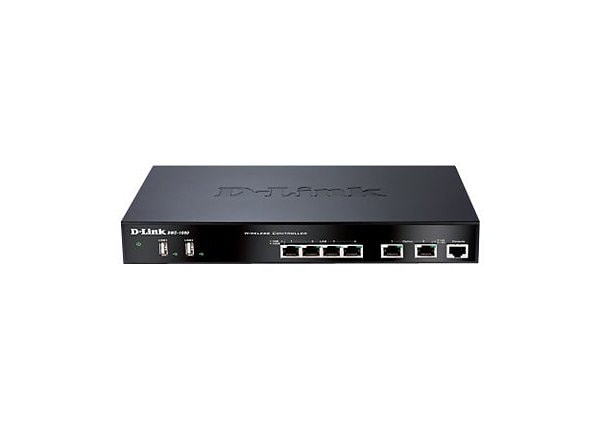
Know your gear
The D-Link DWC-1000 Wireless Controller is a centralized wireless LAN manager developed specifically for campuses, branch offices, and small to-medium enterprises (SMBs) that are looking for an easy to use, scalable solution to manage and configure their wireless network. With the ability to manage up to six wireless Access Points (upgradable to 24) and a maximum of 96 wireless Access Points in a Controller Cluster, the DWC-1000 is a cost effective mobility solution business environments. Its auto-managed Access Point (AP) discovery and single point management allow customers to acquire an enterprise class system without the burden of executing large and complex configurations. With a robust and comprehensive security detection system, the DWC-1000 also enables managed APs to block potential attacks from unauthorized users and devices, especially for wireless environments.
The DWC-1000 features a self-organizing, self-optimizing, and self-healing network capability to increase the stability of the entire wireless network. With scheduled-based wireless frequency scanning and performance analyzing, the DWC-1000 automatically adjusts wireless frequency channels and power periodically to avoid interference and keep the wireless network in an optimized state. For a sudden RF signal vacuum created by any faulty Access Point, the DWC-1000 will increase the transmit output power of neighboring Access Points to expand radiofrequency (RF) coverage.
The DWC-1000 provides a comprehensive wireless security solution for any network. Empowered by a Wireless Instruction Detection System (WIDS), the DWC-1000 detects rogue Access Points and rogue clients as well as anticipates wireless threats, preventing any potential damage and illegal access. In addition to other fundamental wireless security features including WEP, WPA Personal/Enterprise, WPA2 Personal/Enterprise, and MAC Authentication to determine the identity of wireless devices, the Captive Portal feature allows you to block clients from accessing the network until the clients verify their identities. This double-layer authentication and authorization provides a robust security fence to also protect against attacks from within the network.
Many businesses are frequently changing in terms of size and organizational structure. To address such changing needs, the DWC-1000 administrators the opportunity to purchase licenses to upgrade the DWC-1000's capabilities. D-Link offers two types of licenses: an AP license upgrade and a VPN license upgrade. The AP license upgrade increases the number of manageable access points by six, to a maximum of 24 Access Points. The VPN license upgrade enables the DWC-1000 to provide VPN, Router, and Firewall functionality. The firewall function allows administrators to control network access by setting classification policies. The dual Option ports provide link failover and provide Internet connection redundancy to ensure Internet access. The virtual private network (VPN) features provide secure remote control to manage access points in branch offices. Site-to-site VPN tunnels use IP Security (IPSec) Protocol, Point-to-Point Tunneling Protocol (PPTP), or Layer 2 Tunneling Protocol (L2TP) to facilitate branch office connectivity through encrypted virtual links. In addition, the Secure Sockets Layer (SSL) VPN tunnels empower your mobile workers by providing remote access to a central corporate database. Both license options offer scalability, flexibility and increased functionality for potential business growth.
Centralized remote control of managed access points provide a simple way to automatically discover compatible D-Link Wireless Access Points, add them into the managed access point list, and configure them with one-time configuration dispatch settings. With the controller clustering feature, the administrator can easily log into one wireless controller and perform essential configurations on others within the group. The real-time monitoring of acc
The DWC-1000 features a self-organizing, self-optimizing, and self-healing network capability to increase the stability of the entire wireless network. With scheduled-based wireless frequency scanning and performance analyzing, the DWC-1000 automatically adjusts wireless frequency channels and power periodically to avoid interference and keep the wireless network in an optimized state. For a sudden RF signal vacuum created by any faulty Access Point, the DWC-1000 will increase the transmit output power of neighboring Access Points to expand radiofrequency (RF) coverage.
The DWC-1000 provides a comprehensive wireless security solution for any network. Empowered by a Wireless Instruction Detection System (WIDS), the DWC-1000 detects rogue Access Points and rogue clients as well as anticipates wireless threats, preventing any potential damage and illegal access. In addition to other fundamental wireless security features including WEP, WPA Personal/Enterprise, WPA2 Personal/Enterprise, and MAC Authentication to determine the identity of wireless devices, the Captive Portal feature allows you to block clients from accessing the network until the clients verify their identities. This double-layer authentication and authorization provides a robust security fence to also protect against attacks from within the network.
Many businesses are frequently changing in terms of size and organizational structure. To address such changing needs, the DWC-1000 administrators the opportunity to purchase licenses to upgrade the DWC-1000's capabilities. D-Link offers two types of licenses: an AP license upgrade and a VPN license upgrade. The AP license upgrade increases the number of manageable access points by six, to a maximum of 24 Access Points. The VPN license upgrade enables the DWC-1000 to provide VPN, Router, and Firewall functionality. The firewall function allows administrators to control network access by setting classification policies. The dual Option ports provide link failover and provide Internet connection redundancy to ensure Internet access. The virtual private network (VPN) features provide secure remote control to manage access points in branch offices. Site-to-site VPN tunnels use IP Security (IPSec) Protocol, Point-to-Point Tunneling Protocol (PPTP), or Layer 2 Tunneling Protocol (L2TP) to facilitate branch office connectivity through encrypted virtual links. In addition, the Secure Sockets Layer (SSL) VPN tunnels empower your mobile workers by providing remote access to a central corporate database. Both license options offer scalability, flexibility and increased functionality for potential business growth.
Centralized remote control of managed access points provide a simple way to automatically discover compatible D-Link Wireless Access Points, add them into the managed access point list, and configure them with one-time configuration dispatch settings. With the controller clustering feature, the administrator can easily log into one wireless controller and perform essential configurations on others within the group. The real-time monitoring of acc
Enhance your purchase
To Top



